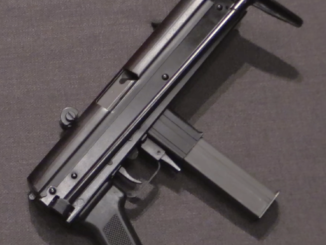The Gepárd M6 is the result of nearly 3 decades of development. The Hungarian military first requested a .50-caliber anti-material rifle circa 1987, and the M1 design submitted was a single-shot rifle chambered for the 12.7x108mm Russian cartridge. This was an accurate gun, but slow to reload, and a semiautomatic M2 was developed shortly thereafter, followed closely by an M3 semiauto chambered for the 14.5x114mm (!) cartridge. By the late 1990s, improved versions of both the semiauto (M4) and a bolt action variant (M5) were being produced. Finally, the M6 emerged from the M4, giving the rifle its current form.
The M6 “Hiúz” (Lynx) is a long-recoil, rotating bolt rifle fed by a single stack 5-round magazine. It can use either 12.7mm Browning or 12.7mm Russian with a change of bolt and barrel, It is a bullpup design, and only usable right-handed. It is in current use by the Hungarian military as well as a handful of other military and security organizations and commercial/civilian sales.




I think that is a very elegant design, I am very interested to see how it does when you take it to the range. I have always found long recoil systems to be interesting, I love shooting my Remington Model 11, it does much to reduce felt recoil in the shotgun, so I suspect that this will be much more pleasant to shoot than some of the 50 cal single shot rifles. Thanks for another interesting one Ian!!
What is the benefit of long recoil mechanism in this context? I do not see it unless combined with hydraulic brake, such as on artillery pieces.
As Ian stated – early in the video – the long recoil allows a greater distance to absorb recoil as the barrel recoils its full stroke. The barrel is probably the single heaviest component in the rifle. The barrel ahs to recoil the full length of the cartridge. That long stroke means that it has more inches to absorb recoil.
IOW this long recoil mechanism has to absorb fewer tons per inch of travel, reducing th
e peak load of recoil during any given micro-second or millimeter of barrel travel.
the long recoil allows a greater distance to absorb recoil as the barrel recoils its full stroke.
—————-
I disagree. At free (unchecked) recoil, impulse > momentum > energy. What you started with, you are bound to end up with. You cannot runaway from it.
Even ignoring the nuances of biomechanics it’s still the force which disrupts the aim and causes fatigue (and bruising) and you can end up with a varying degrees of force. See constant recoil systems.
This is not “constant recoil” system. It stops hard into butt.
I suggest to take this contraption next to Serbu semi-auto .50cal (hard locked) and Barret M82 (short recoil w/ accelerator). I bet this will kick the most. It can be easily objectively proven at ballistic pendulum.
This is not a constant recoil system, obviously (I shudder to imagine the size of 50cal constant recoil) but the principle is broadly comparable.
Ballistic pendulum would indicate the impulse transferred, not force exerted.
“(…)shudder to imagine the size of 50cal constant recoil(…)”
Keep calm, you do not have to do so thanks to Russ Robinson who in 1942…1943 developed Robinson S.R. Model 9 Machine Rifle see 1st photo from top https://guns.fandom.com/wiki/Robinson_SR-9
I agree, but the aim here is not full auto capability, but low wear down of the shooter and precision. Long recoil messes up bursts, because you have varying force applied on your shoulder and very short time for recovery in between the rounds, but it’s better for single shots. Sure, the momentum absorbed by the shooter is the same, but it is transferred to the shoulder by longer applied lower force, thus less pain, less wear down. Furthermore, human body is sensitive to speed / energy more than to momentum, so heavy barrel hitting the end of travel slowly is easier on you.
And precision is better, since very low reaction force on the locked group arises while the bullet is in the barrel. On the other hand, realigning the scope to the barrel is problematic.
With non recoiling barrel, reaction force arises as soon as the bullet starts to travel and is usually not concentric with the bore.
So yes, you cannot run away from it, but you can absorb it the way that fits your situation the best.
Merry Christmas
True enough which is why it is referred to as “perceived” recoil reduction. It is the “perception” of the nut behind the butt.
“…What you started with, you are bound to end up with. You cannot runaway from it…”(C)
This is not entirely true.
With a correctly calculated system, it is possible to significantly reduce the recoil momentum at the exit from the system due to the transitions from the recoil momentum to the energy of the springs in the momentum of the entire rifle.
It looks like magic, but there is no miracle.
Energy stored to return spring(s) is a FRACTION of recoil force energy. If you want to condition you mind to believe it helps, it is up to you. It is all about perception isn’t it?
One can say: “it kicks like a mule”. Some brave guy next to you will say: “it does not kick at all”. You be the judge.
“Energy stored to return spring(s) is a FRACTION of recoil force energy. If you want to condition you mind to believe it helps, it is up to you. It is all about perception isn’t it?”(С)
And you try (for a change) not to depict “what goes where” on your fingers, but to calculate on a calculator how energy is distributed within the system when firing.
And everything will become clear.
If the recoiling barrel and breech are converting their inertial energy into stored mechanical energy in the two operating system springs over duration of first half of cycle time, rather than imparting all of it directly to shooter’s shoulder as a locked breech, fixed barrel system does in a very much shorter time (as long as it takes projectile & propellant gasses to exit muzzle!), would you not agree that the shooter’s shoulder experiences a VERY different thrust/time profile? And that longer duration/lower peak impulse could be less painful?!
Having fired the same ammunition in both types of systems, experientially, the recoil impulses ARE very different.
You are missing one important part – the mass involved. If you fire a weapon with solid lockup, you have the entire weapon mass in your favour to resist the impulse. It will commence to move, thus producing energy into your shoulder. If you hold your weapon snug, you can mitigated it to great degree.
It you however let only part of the mass move, it will pickup substantially higher velocity. That being squared to second power will produce a lot more energy. It will eventually hit your shoulder albeit indirectly. If you smartly arrange a buffer of sort in between, you may be a bit better of, but not significantly.
Lower chamber pressure at the time the bolt unlocks?
Higher or lower, it always have to be safe to unlock.
That muzzle device… Reduces the bolt and barrel speed on a long distance resulting softer bolt impact… In case of short recoil… The muzzle device would reduce the speed of all the gun but the bolt, resulting a terrible bolt impact with this mass… IMHO.
Yes it does reduce, but it is a delicate affair. There ALWAYS has to be a surplus of Energy for a system to function reliably. At the end you can hardly tell if it is “just enough” or “too much”. In my cheeky opinion.
“What is the benefit of long recoil mechanism in this context?(…)”
There is one method to positively undoubtedly ultimately determine that…
Retrieve and comprehend patents pertaining to this weapon.
Sadly I do not know Magyar, so it is not in my power to do so.
Hi Daweo,
They should actually be EU patents in English or with English translations available
Failing that, there’s always that very reliable Monty Python English-Hungarian and Hungarian-English phrase book.
Interestingly I found English-language leaflet by designer of this rifle, but pertaining to his earlier work – namely M1
http://m.ludita.uni-nke.hu/repozitorium/bitstream/handle/11410/9895/Angol%20t%C3%A9zisf%C3%BCzet.?sequence=3&isAllowed=y
Interestingly there existed adaptors allowing using said weapon with PKMSz machine gun tripod and to the DSK heavy machine gun tripod
Something malfunctioned with link I provided, please copy whole of it and paste in address bar to access.
“(…)They should actually be EU patents in English or with English translations available(…)”
It is so if patents were filled before 2004 (Hungary joining EU)?
“What is the benefit of long recoil mechanism in this context?(…)such as on artillery pieces.”
After manufacturer site https://gm6lynx.com/ it seems that advantage is same as in last case – ability to make more compact package for transport, as said site claims
Full (combat) length: 1114 mm
Length in portable state (barrel pushed in): 914 mm
Funny some of the bolt design looks (few small similarities) like Eugene’s Stoner 63 machinegun.
I wonder if this has to be tuned up like a Browning long-recoil weapon. Long-recoil action tends to have more complications because the barrel has its own recoil spring separate from the bolt’s return spring. I could be wrong.
It seems like the tuning is on the muzzle break, rather than the friction collet that is used on the Browning long recoil designs
The simple adjustment of the GM6 muzzle-brake is an elegant solution to the problem of tuning a long-recoil action!
I shudder to think about how many hundreds of hours of machining are required to manufacture all those tight tolerances.
Here is a question for your next Q & A: which gun parts need the tightest tolerances versus which parts can have the loosest fit?
I am assuming that bolt-to-barrel lock-up requires tight tolerances, but the farther you move out from the chamber, the looser tolerances can be. In an extreme case, a stock could be made of any piece of axe-split fence rail (see Abraham Lincoln’s first skill).
Ironically, the bore can be incredibly sloppy if you do not care about accuracy.
Sounds like a really long history of development.
This one can – hopefully – finally shoot right through wine barrels of the Slovak part of the Tokaj wine region?
Ian, might you someday find and review the (20×110 mm Hispanio) Croatian RT-20 recoilless anti materiel rifle?
This is a good example of good design.
Although, the product is still clearly raw and needs to be fine-tuned.
It looks too complicated for mass production.
This is probably very expensive.
It looks like it could use a MG34 bipod.
Good story, I’ve been waiting for it for three years.
With bolt locking being done by a spring…
Is there anything to prevent firing with the bolt unlocked if something happens to the locking spring?
Thanks to this community for pointing me towards the Robbinson WWII .50BMG full auto/burst prototypes. 50+ years of gun needing and the bottom of the rabbit hole has never been in sight!
Energy management and thrust applied over time is something I think about a lot in other systems, perhaps I need to think of continuous recoil systems from the perspective of how and why gas turbine engines, Wankel or Bricklin might manage forces applied to their own structures and engine mounts in a less destructive way than a single cylinder 2 cycle engine does…
Blow forward barrel action that doesn’t come to a hard stop, buffered or not. A revolving breech system with axis 90° to bore, not slamming into end of travel, possibly even providing some gyroscopic stabilization at high cyclic rates.
Rotary feed rather than reciprocating feed.
Find all the energy moving in the system and ballance it.
Has anybody here had to adjust a GM6Lynx? The barrel keeps jamming. The bolt carrier group isn’t separating. Sero said to adjust the brake.All the way in or out had no difference. Incredible firearm though!